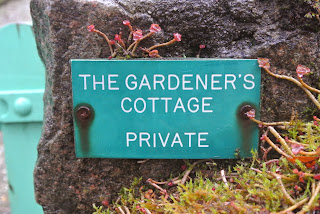Today we were met by Patrick Temple at our hotel who escorted us to his family estate where his mother Elizabeth has spent the past 25 years lovingly creating Salthill Gardens, a one acre walled garden within the grounds.
Upon arrival we were warmly greeted by Elizabeth and here husband Lynne, and were treated to the most wonderful coffee (Elizabeth swears it is the well water) and cakes in the refurbished old piggery, now a cozy studio/lounge area. Having gotten acquainted we set off to tour the garden and grounds which overlook Donegal Bay, an idyllic borrowed landscape for Salthill. Given the proximity to the ocean there have been challenges and benefits to the creation of the gardens, as Elizabeth explained, one must be careful of the salt tolerance of the plants as well as the soil requirements, as the ground is heavy clay and quite alkaline so many of the plants in the garden are a result of trial and error. However, Elizabeth has passion and perseverance in spades, as evidenced by the fabulous garden and its structures, truly a pleasure to spend a morning in, only amplified by the warmth and hospitality of our hosts!!!
On a side note, Patrick runs the family business Magees in Donegal Town, and they are the premier makers of Donegal Tweed in the area, still produced by hand and supply the likes of Burberry and Ralph Lauren. Fantastic!
From Donegal we departed for Dunveagh National park to meet up with the second head gardener Mark McFadden and Failte Ireland representative Maire Aine Gardiner at 12 pm at Dunveagh Castle. Our GPS however, decided to deposit us dead centre of the park in a valley of grasses and heather, surrounded by imposing barren mountains on either side, with not a building, car, or tree in sight. Clearly we had made a wrong turn, but a local sheep farmer came to our aid and pointed us in the right direction.
Fortunately, our hosts were patiently awaiting us, an hour after our scheduled arrival! And on a Sunday no less. Luckily for us, as they gave us the most wonderful private tour of the extensive gardens and the castle itself.
Given the barren landscape that surrounds the castle and grounds, it is truly astonishing to see the lush collection of plant material contained within. There are plants from around the world, and Mark possesses an encyclopedic knowledge of all the trees, shrubs, and perennials, putting us to shame! For us however, the most astounding plants in the gardens were the rhododendrons, hundreds of them, some so tall we mistook them for magnolia trees! Coming from Toronto, this is seriously depressing, but our spirits were lifted by the beautiful symmetry of the Italian garden, the serenity of the Japanese garden, and the simplicity of the Tuscan garden.

We were then happy to enter the castle for our tour to escape the cold rain and warm up. And this castle is one of the coziest we have ever been in! Rich linen wallpaper (ORIGINAL), hand woven carpets, and a diverse and impressive collection of antiques gathered by the former inhabitants of the residence. Of note however, was the deer motifs that embellished everything from the fine china, silverware, and other antiquities within.
We then left for Letterkenny, our final destination for the day, where we ended our day with a brilliant curry dinner at Chili Shakers. Have the duck vindaloo, trust us, it was amazing, incredible heat with complex flavours, an absolute must try.
And what night would be complete without a few pints and some Irish fiddling?
www.failteireland.iewww.glenveaghnationalpark.ie






















































